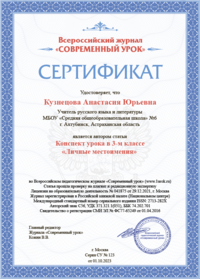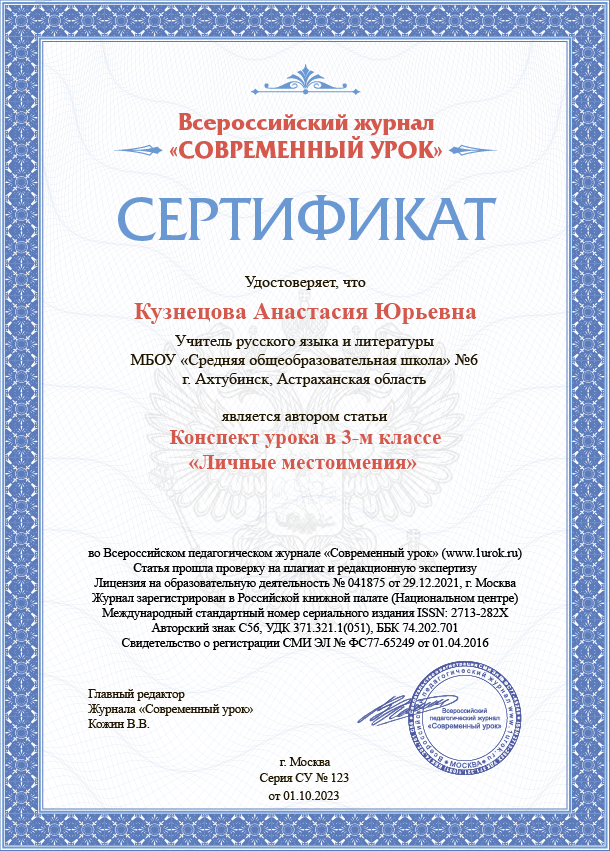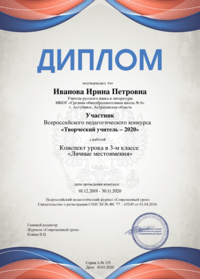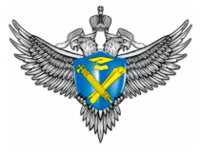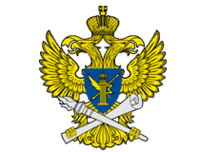Урок английского языка в 11 классе «Преступление и наказание» («Crime and punishment»)
Автор: Бондарева Маргарита Романовна
Организация: ГБОУ СОШ №310 Фрунзенского района Санкт-Петербурга ''Слово''
Населенный пункт: г. Санкт-Петербург
Цель: введение и первичное закрепление лексики по теме «Преступление и наказание»
Задачи:
- предоставить учащимся возможность самостоятельно сформулировать тему урока
- повторить изученные ранее и ввести новые слова и выражения по теме «Crime and punishment»
- закрепить новую лексику, создать прочные лексические связи
- развивать умения говорения, изучающего чтения и письма
- получить обратную связь и обобщить новый материал
Планируемые образовательные результаты:
|
Предметные |
Личностные |
Метапредметные |
|
Развитие языковой компетенции (лексического навыка распознавания и употребления слов по теме); развитие речевой компетенции
|
Развитие ценностно-смысловых установок и приобщение к моральным нормам; расширение эмоционально-ценностного диапазона; воспитание культуры поведения |
Развитие навыка целеполагания в учебной деятельности; развитие умения устанавливать причинно-следственные связи, анализировать и синтезировать информацию; развитие коммуникативной компетенции |
Универсальные учебные действия (УУД):
|
Личностные |
Познавательные |
Коммуникативные |
Регулятивные |
|
Формирование ответственного отношения к учению, готовности и способности обучающихся к саморазвитию и самообразованию на основе мотивации к обучению и познанию, осознанному выбору и построению дальнейшей индивидуальной траектории образования на базе ориентировки в мире профессий и профессиональных предпочтений, с учетом устойчивых познавательных интересов, а также на основе формирования уважительного отношения к труду, развития опыта участия в социально значимом труде; формирование осознанного, уважительного и доброжелательного отношения к другому человеку, его мнению, мировоззрению; развитие морального сознания и компетентности в решении моральных проблем на основе личностного выбора, формирование нравственных чувств и нравственного поведения, осознанного и ответственного отношения к собственным поступкам |
Умение определять понятия, создавать обобщения, устанавливать аналогии, классифицировать, самостоятельно выбирать основания и критерии для классификации, устанавливать причинно-следственные связи, строить логическое рассуждение, умозаключение (индуктивное, дедуктивное и по аналогии) и делать выводы |
Умение организовывать учебное сотрудничество и совместную деятельность с учителем и сверстниками; работать индивидуально и в группе: находить общее решение и разрешать конфликты на основе согласования позиций и учета интересов; формулировать, аргументировать и отстаивать свое мнение; умение осознанно использовать речевые средства в соответствии с задачей коммуникации для выражения своих чувств, мыслей и потребностей; планирования и регуляции своей деятельности; владение устной и письменной речью, монологической контекстной речью |
Умение самостоятельно определять цели своего обучения, ставить и формулировать для себя новые задачи в учебе и познавательной деятельности, развивать мотивы и интересы своей познавательной деятельности; умение соотносить свои действия с планируемыми результатами, осуществлять контроль своей деятельности в процессе достижения результата, определять способы действий в рамках предложенных условий и требований, корректировать свои действия в соответствии с изменяющейся ситуацией |
Ресурсы:
- УМК «Spotlight 11»
- Проектор/Интерактивная доска
- Презентация в программе Microsoft Power Point
- Раздаточный материал
Список источников:
https://docs.yandex.ru/docs/view?tm=1637863343&tld=ru&lang=en&name=Crimes-and-people-who-do-them
https://kidskonnect.com/people/al-capone/
https://www.britannica.com/biography/Timothy-McVeigh
https://www.aratherat.com/blogs/home-page/carl-gugasian-the-most-prolific-bank-robber-in-u-s-history
Ход урока
|
Этап урока |
Время |
Деятельность учителя |
Деятельность обучающихся |
Организационные формы работы |
Методы/приемы работы |
|
Организационный этап |
1 мин. |
Приветствует обучающихся |
Приветствуют учителя |
Фронтальная |
- |
|
Этап мотивации к получению новых знаний |
2 мин. |
Демонстрирует картинки, предлагает определить лишнюю, описать героев и с опорой на них догадаться о теме предстоящего урока |
Определяют, какая картинка лишняя, называют имена известных людей и персонажей, формулируют тему урока |
Фронтальная |
Опрос |
|
Речевая зарядка |
3 мин. |
Предлагает обучающимся ответить на вопросы по теме урока, обсудить их и высказать свою точку зрения |
Отвечают на вопросы, соглашаются или не соглашаются с мнением друг друга, аргументируют |
Фронтальная |
Обсуждение |
|
Ориентировочно-подготовительный этап формирования лексического навыка |
9 мин. |
1.Демонстрирует на слайде первую группу новых лексических единиц, предлагает обучающимся семантизировать их с помощью дефиниций. 2.Организует в парах работу по словообразованию, предлагает заполнить таблицу (приложение 1), проверяет. 3. Демонстрирует на слайде вторую группу новых лексических единиц, предлагает догадаться об их значениях по картинкам |
1.Записывают новые слова, переводят их, используя значения, указанные на слайде 2. Работают в парах, заполняют таблицу, образуя от существительных глаголы и род деятельности. 3. Записывают новые слова, переводят их |
Индивидуальная Парная Фронтальная |
Перевод Заполнение таблицы
|
|
Стереотипизирующе-ситуативный этап формирования лексического навыка |
9 мин. |
1. Предлагает обучающимся задание на заполнение пропусков для закрепления новой лексики, проверяет. 2. Просит обучающихся выразить своё мнение и обсудить его в парах: какое из преступлений является самым серьёзным, а также, какое наказание можно получить за каждое из преступлений. |
1. Выполняют упражнение на заполнение пропусков, устно проверяют вместе с учителем. 2. Обсуждают вопросы в парах, а затем делятся своим мнением со всем классом. |
Индивидуальная Фронтальная Парная |
Заполнение пропусков Обсуждение |
|
Варьирующий ситуативный этап формирования лексического навыка |
20 мин. |
1. Предлагает обучающимся работу в группах: каждая из групп получает текст с биографией известного преступника (Приложение 2), на основе которой необходимо заполнить «отчёт присяжного» (Приложение 3) и вынести преступнику приговор. 2. Просит обучающихся в парах составить диалог, используя 7 слов, изученных за урок. |
1. В группах изучают полученный текст, знакомятся с жизнью бандита и совершёнными им преступлениями, заполняют выданную форму и определяют способ наказания. 2. В парах составляют диалоги. |
Групповая Парная |
Изучающее чтение Обсуждение Диалог |
|
Этап рефлексии |
2 мин. |
Задает учащимся вопросы о том, что они запомнили за урок, чему научились, слушает их ответы, поощряет |
Обобщают информацию, полученную на уроке, выделяют ту, которая значима лично для них, используют полученный языковой навык в устной речи |
Фронтальная |
Опрос |
|
Заключительный этап |
1 мин. |
Задает и комментирует домашнее задание на следующий урок |
Записывают домашнее задание, задают уточняющие вопросы |
Фронтальная |
Объяснение |
Бондарева Маргарита Романовна 19.11.2021
Приложение 1
|
ACTION (=noun) |
CRIMINAL (=person) |
ACTION (=verb) |
|
theft (general word for stealing) |
|
|
|
robbery (steal from places, e.g. banks) |
|
|
|
burglary (breaking into houses and steal things) |
|
|
|
shoplifting (steal from shops when they’re open) |
|
|
|
pickpocketing (stealing from smb’s pocket without them noticing) |
|
|
|
murder (killing someone by intention) |
|
|
|
mugging (attacking someone and stealing their money) |
|
|
|
vandalism (damaging property belonging to other people) |
|
|
|
kidnapping (taking a person away illegally by force) |
|
|
Приложение 2
Group 1. Alphonse Capone
Alphonse Capone was born in Brooklyn, New York, to a poor family from Italy who came to America for a better life. His father, Gabriele Capone, was a barber while his mother, Teresa Capone, worked as a seamstress (швея).
Capone was a student in a Catholic institution. He was a promising student but was expelled at the age of 14. His teacher had hit him for impudence (дерзость) and he struck back.
The Capones moved to a better home in Park Slope in Brooklyn. It was here where Alphonse would meet his future wife, Mary ‘Mae’ Coughlin, and his mob (банда) mentor, Johnny Torrio. Johnny “Papa Johnny” Torrio was Al Capone’s greatest influence in the world of racketeering (бандитизм).
Torrio introduced Capone to Frankie Yale, a gangster who employed Capone as a bartender and bouncer (вышибала) in Coney Island’s Harvard Inn. It was here that Capone was involved in a scrape (передряга) which earned him the nickname ‘Scarface’.
At the age of 19, Capone married Mary ‘Mae’ Coughlin. Weeks before their wedding Mary gave birth to their son, Albert Francis “Sonny” Capone. Johnny Torrio was the godfather.
Capone and his family moved to Baltimore to turn over a new leaf. He worked as a bookkeeper in a construction company. When Capone’s father died due to heart attack Torrio asked Capone to join him in Chicago, and he accepted the offer.
Torrio’s name was big in businesses related to gambling (азартные игры) and prostitution. Torrio was working for the crime boss James “Big Jim” Colosimo and hired Capone as an enforcer*. After Colosimo’s death Torrio took over the empire. Rumor has it that Torrio hired Capone to kill Colosimo.
When the 18th amendment (поправка) was enacted and prohibited the sale and consumption of alcohol, Torrio shifted to bootlegging (тайная торговля спиртными напитками) operations. Torrio made Capone his co-manager in the business because of his skills with numbers from being a former bookkeeper.
Capone was reputed as a troublemaker. His first imprisonment was when he hit a parked taxicab due to driving under the influence of alcohol. Torrio used his political connections to free him.
Capone moved his headquarters (штаб-квартира) to the Metropole Hotel in downtown Chicago and began living a luxurious lifestyle. His business’ annual revenue was estimated by the newspapers at around $100 million.
Capone was compared to Robin Hood due to his generous personality and his working on the side of the masses. He donated a large amount of money to charities and even opened a soup kitchen later on during the Depression.
Capone ordered his men to shoot and kill his enemies in Cicero. The three men were gunned down and it led to a public outcry for justice. No evidence was presented involving Capone. Instead, the police raided (совершать облаву) Capone’s business and collected documents which would be used to charge Capone with income tax evasion (уклонение от налогов).
In 1929, Capone was linked to the attempted assassination (покушение) of his rival ‘Bugs’ Moran, the leader of the North Side gang, and with ordering the St. Valentine’s Day Massacre (резня). The public blamed Capone for the massacre and he was given the name ‘Public Enemy Number One’
*enforcer - a violent criminal employed by a crime syndicate to make people obey a rule, or make a particular situation happen
Источник: https://kidskonnect.com/people/al-capone/
Group 2. Timothy McVeigh
Timothy McVeigh was the middle child in a blue-collar (рабочего класса) family in rural New York State, and he expressed an interest in guns from an early age.
He graduated from high school and spent a short period at a local business college. Around this time he first read The Turner Diaries (1978), an antigovernment, neo-Nazi tract written by William Pierce. The book, which details the truck-bombing of the Washington, D.C., headquarters (штаб-квартира) of the Federal Bureau of Investigation (FBI), fueled (разжигать) McVeigh’s paranoia about a government plot (заговор) to repeal (отменить) the Second Amendment (поправка) of the U.S. Constitution, which guarantees the right “to keep and bear arms (оружие).”
He enlisted in the U.S. Army and proved to be a model soldier, earning a Bronze Star for bravery in the Persian Gulf War (1990–91). He was a candidate for the Special Forces but dropped out of the program after only two days. The experience soured (портить) him on the military, and he took an early discharge and left the army.
McVeigh returned to New York but was unable to find steady work. He reunited with Terry Nichols and Michael Fortier, friends from his days in the army, and sold guns at fairs throughout the United States.
He drove to Waco, Texas, to observe the ongoing FBI siege (осада) of the Branch Davidian compound. The compound belonged to the religious sect Branch Davidians. Suspecting this group of stockpiling illegal weapons, the Bureau of Alcohol, Tobacco, and Firearms (ATF) obtained a search warrant (ордер) for the compound and arrest few of the group's members. An intense gunfight erupted, resulting in the deaths of four government agents and six Branch Davidians. A siege lasting 51 days was initiated by the Federal Bureau of Investigation (FBI). Eventually, the FBI launched an assault (нападение) and initiated a tear gas attack in an attempt to force the Branch Davidians out of the ranch. Shortly thereafter, the Mount Carmel Center became engulfed (охватить) in flames. The fire resulted in the deaths of 76 Branch Davidians, including 25 children and two pregnant women.
McVeigh viewed the U.S. government’s actions there as illegal, and it was during this time that McVeigh, Nichols, and Fortier made contact with members of militia groups in the Midwest.
McVeigh began actively plotting to destroy the Alfred P. Murrah Federal Building in Oklahoma City. Over the next six months, McVeigh and Nichols planned the bombing and acquired several tons of ammonium nitrate fertilizer, which, combined with fuel oil, would provide the explosive power for the bomb. On April 19, 1995, the second anniversary of the deadly fire that ended the Branch Davidian siege, McVeigh parked the truck containing the bomb in front of the Murrah Building.
At 9:02 AM, the bomb went off, tearing off the front of the building, killing 168 people, and injuring more than 500.
Slightly more than an hour later, McVeigh, driving a getaway (побег) car that he and Nichols had placed a few days earlier, was pulled over by a Oklahoma state police officer for a license plate (номерной знак) violation. When the officer discovered that McVeigh was illegally carrying a concealed (тайный) handgun, McVeigh was arrested and held in jail, pending a trial on the gun charge. While he was in custody (под стражей), McVeigh was identified as “John Doe No. 1,” the primary suspect in the Oklahoma City bombing.
Источник: https://www.britannica.com/biography/Timothy-McVeigh
Group 3. Carl Gugasian
Carl Gugasian was born in Pennsylvania to Armenian parents Andranik and Sanassan. When he was 15, he was shot while trying to rob a candy store and was sent to a State Youth Facility for 18 months.
After finishing High School he studied for a bachelor’s degree in electrical engineering, and in 1971 enrolled in the army. While in the military, he received tactical weapons and special forces training. Afterwards, he returned to education and got a master’s degree in systems analysis, followed by doctoral work in statistics and probability.
Gugasian was often seen in the neighborhood running with a weighted backpack to build strength and endurance (выносливость). He was into yoga, meditation and health foods. He liked to travel - he visited Paris, Africa and Armenia. According to tax returns, he was a self-employed statistical consultant and professional gambler (азартный игрок), which explained why he had half a million dollars in the bank.
For almost three decades, he had been successfully robbing banks with a professionalism that had earned grudging (невольный) respect from law enforcement. Nobody knew the raider's (грабитель) identity, but his robberies had made him a legend. He was the most prolific (плодовитый), bank robber in U.S. history netting himself around $2 million, out-thieving John Dillinger and Bonnie and Clyde combined.
The modus operandi (образ действий) was nearly always the same. He worked alone. Armed, wearing baggy clothes and a tight-fitting mask - often Freddy Krueger, the robber would always strike on a Friday night about 10 minutes before closing. He would be referred to as the "Friday Night Bank Robber". His apparent (несомненный) superhuman athleticism was just as alarming as his gun and loud voice. From a standing position he would nimbly (проворно) leap onto the counter, rifle (стрелять) the drawers, grab the cash and be out in under two minutes.
The robberies typically took place between October and April when night fell early. The banks were all located near woods and forests. After the robbery, the masked thief would run into the dark woods and vanish.
The raids were always meticulously (тщательно) planned and expertly carried out. Based on analysis of the crimes, law enforcement could estimate his age, height, and determined he was also very fit and agile (проворный). They also surmised (предполагали) that he may have had a military background.
In 2001, two boys playing in the woods in Radnor, Pennsylvania, found a strange three-foot pipe hidden inside a concrete (бетонный) drain (водосток). Inside, they discovered documents relating to numerous bank robberies and instructions on how to clean a Baretta firearm.
The boys took their find to the police and when an officer returned with them to the woods, he found a three foot deep bunker filled with more pipes and waterproof containers. The bunker was not just a hole in the ground. It had been carefully excavated and lined with bricks and concrete blocks. It contained books, maps, notes on 160 banks from Virginia to Connecticut, 5 guns, 500 rounds of ammunition and 8 Halloween masks.
On February 7th, 2002, Gugasian was arrested at the Philadelphia Free Library. He had been a regular there for years, researching and photocopying topographical maps. Gugasian was stunned (ошеломлён) and originally remained tight lipped (сохранять молчание), but would later confessed his crimes.
Gugasian robbed around 50 banks, stole $2 million, and shot two people – once by accident, once when startled (испугаться) (both survived).
At his questioning were three bank workers from among the scores he had terrorized. It was the first time he had faced a victim without wearing a mask and he did not like the experience. Gugasian had written a one-page letter apologizing for the robberies and traumatizing his victims and he choked with emotion as he read the letter out loud. "I've always rationalized my conduct by believing that robbing banks had no victims" he said. "I don't think that now".
Источник: https://www.aratherat.com/blogs/home-page/carl-gugasian-the-most-prolific-bank-robber-in-u-s-history


